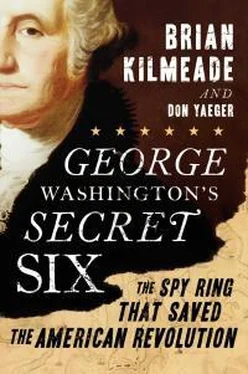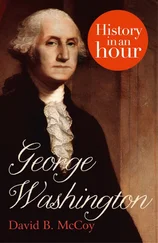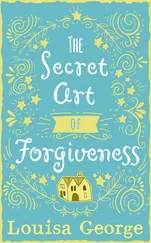Robert Townsendnever spoke of his service, never applied for a pension, never corrected those who assumed he had done nothing but tend his shop during the war, and never, it seems, recovered emotionally from the blow of Agent 355’s capture and imprisonment. After the war he grew even more reserved and reclusive. Dr. Peter Townsend, the son of his brother Solomon, took a particular interest in his somber, silent uncle Robert and often asked him about his service during the war, but the older man was tight-lipped and shared very little. Townsend kept to himself, staying near his brothers and their families but never marrying himself, though he may have fathered a child with his French-Canadian housekeeper in the years following the war. The child—a large, blond, blue-eyed boy who resembled all the Townsend men except the slender, dark Robert—was named Robert Townsend Jr. by his mother, Mary. There was some suspicion that another Townsend brother, the flirtatious William, the “flower of the family,” who happened at that time to share a house with Robert, was actually the father. But Robert, having no other children, took responsibility for the boy’s education and welfare; his will includes bequests for his supposed son, several nephews, and a niece. Townsend developed strong abolitionist beliefs and staunchly opposed any type of slave ownership; later in life he worked on behalf of some former slaves of his father’s to help them gain their freedom. The man once known as Culper Junior died exactly three years after Benjamin Tallmadge, on March 7, 1838, at the age of eighty-four.
Abraham Woodhullmarried Mary Smith in 1781. He spent the rest of his life in Setauket, where he raised three children and served in roles of authority in the Suffolk County government. He never spoke much about his role in the spy ring. Mary died before Abraham; Lydia Terry became his second wife in his final years. He passed away on January 23, 1826, and was buried in the Setauket Presbyterian Church graveyard. In 1936, the Mayflower Chapter of the Daughters of the American Revolution erected the following marker near his simple headstone:
Friend and confidant of George Washington, Head of the Long Island Secret Service During the American Revolution he operated under the alias Samuel Culper, Sr. To him and his associates have been credited a large share of the success of the Army of the Revolution. Born in Setauket Oct. 7, 1750 in the original Woodhull homestead, son of Richard W. & Margaret Smith. Fifth generation from Richard Woodhull, the original grantee of a large portion of Brookhaven Town. He was a Presbyterian, occupying a “Pew of Authority” in the old church and doing much toward the building of the new church. He was a man of integrity punctual and precise in his business relations. He freed his slaves long before they were legally free. He filled numerous important positions being Magistrate in Setauket many years, Judge of the Court of Common Pleas 1793–1799, First Judge of Suffolk Co. from 1799–1810.
Agent 355,whose name and whose fate have both been lost to time, might have escaped imprisonment and gone on to live a long and happy life. Or she might have passed away somewhere in the dark, disease-infested hull of HMS Jersey . When the British left New York in November 1783, they abandoned the Jersey in the harbor, with several thousand starving prisoners still on board.
It is extremely difficult to learn much at all about the lives and deaths of those unlucky enough to have been captured. After the surrender of the British, the former colonists sought to piece together their shattered lives and homes; many records were lost, destroyed, or simply filed away without any thought to their deeper significance. Thousands of individuals were missing from battlefields, prison camps, and prison ships; thousands more were untraceable due to emigration, desertion, or simply westward movement into the newly opened territories beyond the Appalachians. In the mid-nineteenth century, as the generation who lived during the Revolution was passing away, historians made some efforts to reconstruct lists of inmates’ names by interviewing survivors of the Jersey . Though quite rare (and, since they were recalled several decades after the fact, not wholly reliable accounts), women’s names do appear on some of these lists; none have yet been proved to be that of Agent 355.
• • •
For generations, the only Revolutionary War spy immortalized in history books was the brave but ultimately unsuccessful Nathan Hale. Tales of the Culper Ring were relegated to local legend or mystery (who was Culper Junior?). Learning the true identity of Washington’s most consistent and valuable spy in the one city the general valued most was a pursuit undertaken by several prominent researchers, who analyzed the oral traditions and followed up on hunches. Townsend was always among those considered likely contenders, but the spy could not be unmasked until the “wagon full” of his letters was found in 1929 and given over to the care of Morton Pennypacker, who compared the writing with that of surviving Culper letters. At last a much more complete story of the ring could be told.
This momentous discovery was made during a dark and uncertain time in American history. The Great Depression threatened the very fabric of the nation, then all eyes were focused on the upheaval in Europe and the creeping threat in the Pacific. The United States was poised at the brink of its next great chapter and was not concerned with rewriting history. Despite Pennypacker’s efforts to shine a light on these provincial heroes of Long Island, Manhattan, and coastal Connecticut, the Culpers once again sank into obscurity. But even if their story was not known across the nation, the fruits of their labors, their letters, and their lives were—and continue to be—felt from sea to shining sea in the freedoms and independence all American citizens enjoy.
Epilogue
We knew the story of the Culper Ring was important. We knew it was a story whose characters and events should be standard fare in history classes across the country. But what we didn’t know was how relevant it still proves today within the intelligence community of the United States.
In February 2012, we were granted access to CIA Headquarters in Langley, Virginia, where we met with the agency’s chief historian.
Outside the building is a statue honoring Nathan Hale’s courage and patriotism; inside the building are exhibits on various spying operations of the past. But nowhere did we find homage to the Culper Ring—until we sat down for our meeting.
We were stunned to learn that the history of the ring is taught as part of the introductory training for new agents. Whether suggested by Washington or Tallmadge, or simply figured out, through bravery and intelligence, on their own, the methods used by these citizen-spies—the dead drops, the well-crafted backstories, the compartmentalizing of intelligence, the secret encrypted code—are many of the same methods still used today by secret agents the world over.
And like the courageous men and women of our modern covert services, the Culpers worked in profound secrecy. They never sought credit, never received accolades, and never revealed the risks they took or the sacrifices they made to serve our country. Under the unblinking leadership of Benjamin Tallmadge, Washington’s secret six served a newborn nation against a military that was considered to be unbeatable. The observation of Major George Beckwith bears repeating: “Washington did not really outfight the British, he simply outspied us!”
In this book, we have included photographs of some of the places, portraits, and humble graves that bear silent testimony to our nation’s first and most accomplished ring of clandestine operatives.
Читать дальше












